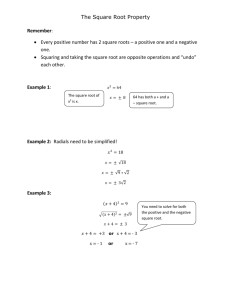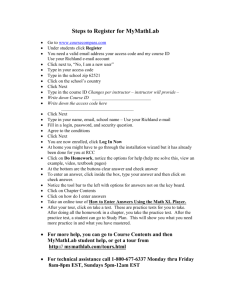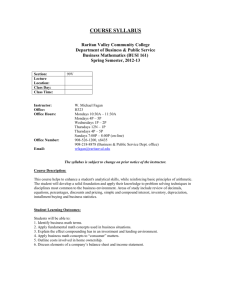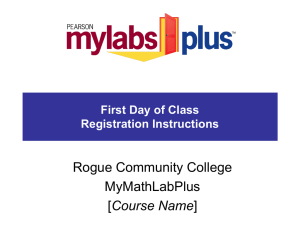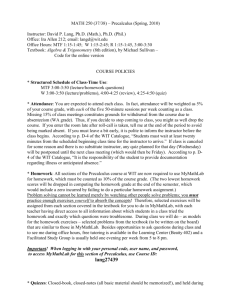Syllabus Spring 2013 Section 02
advertisement
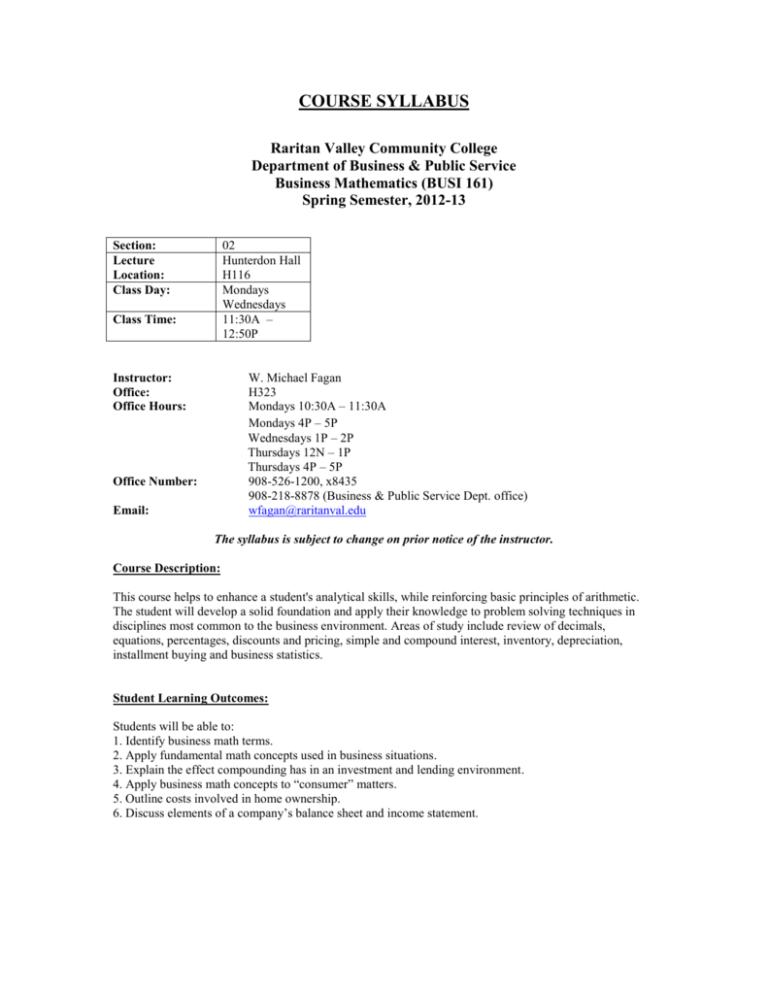
COURSE SYLLABUS Raritan Valley Community College Department of Business & Public Service Business Mathematics (BUSI 161) Spring Semester, 2012-13 02 Hunterdon Hall H116 Mondays Wednesdays 11:30A – 12:50P Section: Lecture Location: Class Day: Class Time: Instructor: Office: Office Hours: W. Michael Fagan H323 Mondays 10:30A – 11:30A Mondays 4P – 5P Wednesdays 1P – 2P Thursdays 12N – 1P Thursdays 4P – 5P 908-526-1200, x8435 908-218-8878 (Business & Public Service Dept. office) wfagan@raritanval.edu Office Number: Email: The syllabus is subject to change on prior notice of the instructor. Course Description: This course helps to enhance a student's analytical skills, while reinforcing basic principles of arithmetic. The student will develop a solid foundation and apply their knowledge to problem solving techniques in disciplines most common to the business environment. Areas of study include review of decimals, equations, percentages, discounts and pricing, simple and compound interest, inventory, depreciation, installment buying and business statistics. Student Learning Outcomes: Students will be able to: 1. Identify business math terms. 2. Apply fundamental math concepts used in business situations. 3. Explain the effect compounding has in an investment and lending environment. 4. Apply business math concepts to “consumer” matters. 5. Outline costs involved in home ownership. 6. Discuss elements of a company’s balance sheet and income statement. Class Materials: Text: Business Math, 9th edition, Cleaves & Hobbes, Prentice Hall (comes bundled with a Study Guide and the access code for the MyMathLab at the Golden Lions Bookstore). NOTE: The 9th edition is the only acceptable version of the text that may be used in this course. There have been changes in the material and its location in the text; therefore older versions will not be appropriate for the course. Use of MyMathLab is required for this course. If you already have the text but need to purchase the access code separately, please go to the following publisher’s web site: http://www.coursecompass.com/html/student_buy_access.html. Calculator: A calculator that can at least do square roots and exponentiation. Please bring your textbook, a calculator, paper, and something to write with to class. Course Routine: Each chapter will be reviewed during class via lecture and problem solving. The lecture is intended to highlight important concepts from the chapter, and explain concepts that may present some difficulty. However, you are responsible for all material in the chapter, including appendices (unless otherwise specifically noted). It is best to study the chapter before the session in which it is discussed. You should include in your readings the Learning Outcomes, “How To” sections, Key Terms, Tip and “Did You Know?” boxes, Examples, and Chapter Summary. For maximum comprehension, try the Stop and Check sections, the Section Exercises, Exercise Sets A and B, and the Practice Test (the Exercise Sets and Practice Test are located at the end of the chapter). The answers to the odd-numbered Section Exercises and Exercise Sets are also in the back of the book. Most of these materials are also available on the MyMathLab webpage for the course. Please make sure you ask questions if you are confused about any concepts in the chapter, whether discussed in class or not. Most chapters will also include some in-class problem-solving work, usually in groups to help improve your understanding of more difficult concepts. Outside of class, there is additional material available via the MyMathLab tool, including the multimedia text, PowerPoint slides, learning videos, and practice exercises. MyMathLab will also develop a study plan for you based on your results. This material is voluntary, but may improve your comprehension of the material. There is also on-line homework (via MyMathLab) for the chapter (select from the Do Homework button on the Course Compass webpage). These assignments will typically be 15 – 20 objective questions corresponding to material in the chapter. Homework is open book/open notes, with no time limit, and you can take it an unlimited number of times during the week. The results are immediately viewable as you do each question. The number of attempts you make on each problem will not be factored into your grade. However, if you find you are not getting the right answer after a reasonable number of tries, please ask the professor for guidance on the problem. A score of 70% or better on the homework for a given chapter is necessary in order to be able to take the quiz for that chapter. After you feel you have mastered the homework, take the quiz for the chapter (select from the Take a Quiz button on the Course Compass webpage). The quizzes will typically be 10 – 15 objective questions corresponding to material in the chapter. They are open book/open notes, but the student is limited to one attempt, and there is a time limit of 45 minutes to complete the quiz. You must have scored 70% or better on the homework for a chapter to be able to take the quiz for that chapter. Grades for the quizzes will be available as soon as you have submitted it for grading. You can work on the homework and quiz for a chapter up to the date where the exam for that chapter closes. For example, you can work on Ch. 5, 6, 7, and 8 up until 03/29/13, which is when the exam period for Exam #2 (which covers those four chapters) concludes. A review of homework/quiz problems in class is available upon request. If you would like solutions to additional problems in the text not assigned as homework, please let me know. Please make sure you have a reliable computer and Internet connection. You only get one attempt to take any given quiz, and I will not accept (on a consistent basis) the excuse that "my computer locked up" or “I lost my Internet connection”. Grades: The evaluation weighting for the final grade will be as follows: Homeworks Quizzes Exams 1, 2, 3, & 4 In-class exercises/ Class participation/ Attendance 10% 20% 60% 10% (drop lowest) (drop lowest) (drop lowest) There will be no makeup exams. Any issues you have with not being able to take the exams on the days they are scheduled must be discussed with me in advance. I will not accept requests to retake quizzes and homeworks, when the requests are made after their due date. There will be no comprehensive final exam. The last Exam (#4) will be held during Final Exam week, but will only cover the new material since Exam #3. The exams will be some combination of multiple choice, true/false, matching, fill-in and problems; and will be delivered via the MyMathLab tool. Exams are open book/open notes. The final 10% of the grade is based on the instructor’s subjective evaluation of the student’s involvement in the course, and will consider attendance/late arrivals, questions/comments during classes, and degree of involvement in class exercises. When the course is complete, grades will be assigned on the following basis: Grade A B+ B C+ C D F % range 90 – 100 85 – 89.9 80 – 84.9 75 – 79.9 70 – 74.9 60 – 69.9 0 – 59.9 Extra Credit: The only extra credit opportunity available in this course is if you participate in one of the following college programs: Service Learning RVCC Internship If you provided documentation from the coordinator of either program (Lori Moog for Service Learning; or Diane Seavers for the RVCC Internships), then you will receive 5% extra credit in calculating your final grade. No other extra credit opportunities will be provided. Dates of Note: Exam 1 Spring Break Exam 2 Exam 3 Exam 4 03/02 – 03/08/13 03/11 – 03/16/13 03/23 – 03/29/13 04/20 – 04/26/13 05/08 – 05/14/13 Ch. 1 – 4 no class Ch. 5 – 8 Ch. 9 – 11 Ch. 12, 16, 19 Attendance: If you stop participating in the class, it is your responsibility to withdraw yourself from the course, or else you may receive a grade of F for the semester. Class Decorum: Please arrive on time for class. Please also attend to any personal business (bathroom, lunch, etc.) before the start of class. Finally, please silence cell phones during class – if you need to take a call (genuine emergency only, please) exit the classroom quickly and quietly. Reasonable Accommodation: Students with disabilities who require accommodations (academic adjustments and/or auxiliary aids or services) for this course MUST provide documentation of accommodations from the RVCC office of Disability Services, C143. No accommodations will be made without this documentation. Recording of the class via any electronic device is prohibited unless specified in an accommodation letter from the Disability Advisor. Getting Help: If you experience difficulties at anytime during the course, there are many ways of getting help. a. Your textbook and MyMathLab. Aside from the text, MyMathLab has an on-line tutoring service. From the MyMathLab main page, click on the “chapter contents” button on the left menu. From the page that opens, click on “Pearson Tutor Services” at the top of the page. The publisher provides one 30 minute tutoring session for free. b. SmarThinking. In addition to the on-line tutoring available in MyMathLab, the college subscribes to a service called “SmarThinking”, which also offers on-line tutoring. See the separate handout about how to access SmarThinking. A student handbook is posted on the instructor’s web site. c. Office Hours. The purpose of these office hours is to provide time for the instructor to help and interact with all of her/his students. If the office hours are not convenient for you, see your instructor to set up an appointment. d. Academic Support Center. RVCC provides its students with mathematics tutors, free of charge, in the Academic Support Center. Tutoring at the Academic Support Center generally begins in the second week of classes. When you go to the Academic Support Center, make sure you sign in at the front counter. Tutors will be at the front counter and also working at the tables. The telephone number for the Academic Support Center is 908-526-1200 Ext. 8393. e. A study group. Students can form study groups to motivate themselves and each other. Study groups can work on homework or study for exams and quizzes. f. Testing Skills and Math Anxiety Workshops. The RVCC Counseling Center offers workshops on many topics and concerns, including test-taking skills, math anxiety, time management, stress management. The schedules and locations of these workshops can be obtained from the Counseling Center. Academic Integrity Policy: Academic freedom is a fundamental right in any institution of higher learning. Honesty and integrity are the foundations of ethical conduct and civility and are necessary preconditions of this freedom. Consequently, the maintenance of academic integrity is the obligation of every member of the Raritan Valley community, and breaches of academic integrity constitute serious offenses. Student Academic Code of Conduct Raritan Valley Community College requires independent, honest work on the part of its students, and students are expected to conduct themselves with scholarly integrity. Academic integrity can be breached by students in one or more of (but not limited to) the following ways (from the RVCC Student Handbook): 1) Copying graded homework assignments from another student. 2) Working together on an assignment without being authorized by the faculty member to do so. 3) Looking at another student's paper during an exam. 4) Copying another student's computer program or class project and submitting it as one's own. 5) Stealing or borrowing all or part of an exam's questions or answers. 6) Entering a computer file without authorization. 7) Giving someone answers to exam question while the exam is being given. 8) Giving or selling a term paper, report, drawing, or computer program to another student for submission to the faculty member. 9) Deceiving a faculty member to improve one's grade. 10) Falsifying data or a source of information. 11) Use of any technology to gain access to test answers, test questions or prohibited materials such as notes, online data bases and web sites during a test. 12) Submitting work for a grade that was executed in another class or previous semester without the instructor's permission. Examples of plagiarism include, but are not limited to: 1) Copying answers from a textbook to submit for a grade. 2) Quoting text or other works without citation when requested by the faculty member to present one's own work. 3) Submitting a paper or essay obtained from a term paper service or taken from the Internet. 4) Submitting a paper or report written by another student, a spouse, or a colleague as one's own. 5) Submitting another student's project, essay, research paper, or computer program as one's own. 6) Submitting a paper wholly or in substantial part using the exact phrasing of source material. 7) Submitting a paper closely paraphrased from source material, where the original source material is simply edited with perhaps minor word changes occurring. 8) Submitting a paper closely paraphrased from source material, splicing together sentences from scattered segments of the original. The following penalties for confirmed cheating and plagiarism apply: First offense: The faculty member will have the authority to issue a failure on the paper, exam, assignment, or course on which cheating or plagiarism was established. In general, plagiarism that the faculty member considers to be serious and proven shall result in failure for the course. Subsequent offenses(s): As with the first offense, the faculty member will have the authority to issue a failure on the paper, exam, assignment, or course on which cheating or plagiarism was established and must report the violation. Upon confirmation of the student's subsequent offense by the Dean of Academic and Student Services, the student will be subject to suspension from the college. The current college catalog and student handbook are important documents for understanding your rights and responsibilities as a student in the RVCC classroom. Please read your catalog and handbook as they supplement this syllabus. TOPICS COVERED Chapter 1 2 3 4 5 6 7 8 9 10 11 12 15 16 19 Topic Review of Whole Numbers and Integers Review of Fractions Decimals Banking Equations Percents Business Statistics Trade and Cash Discounts Markup and Markdown Payroll Simple Interest and Simple Discount Consumer Credit Building Wealth Through Investments Mortgages Insurance
